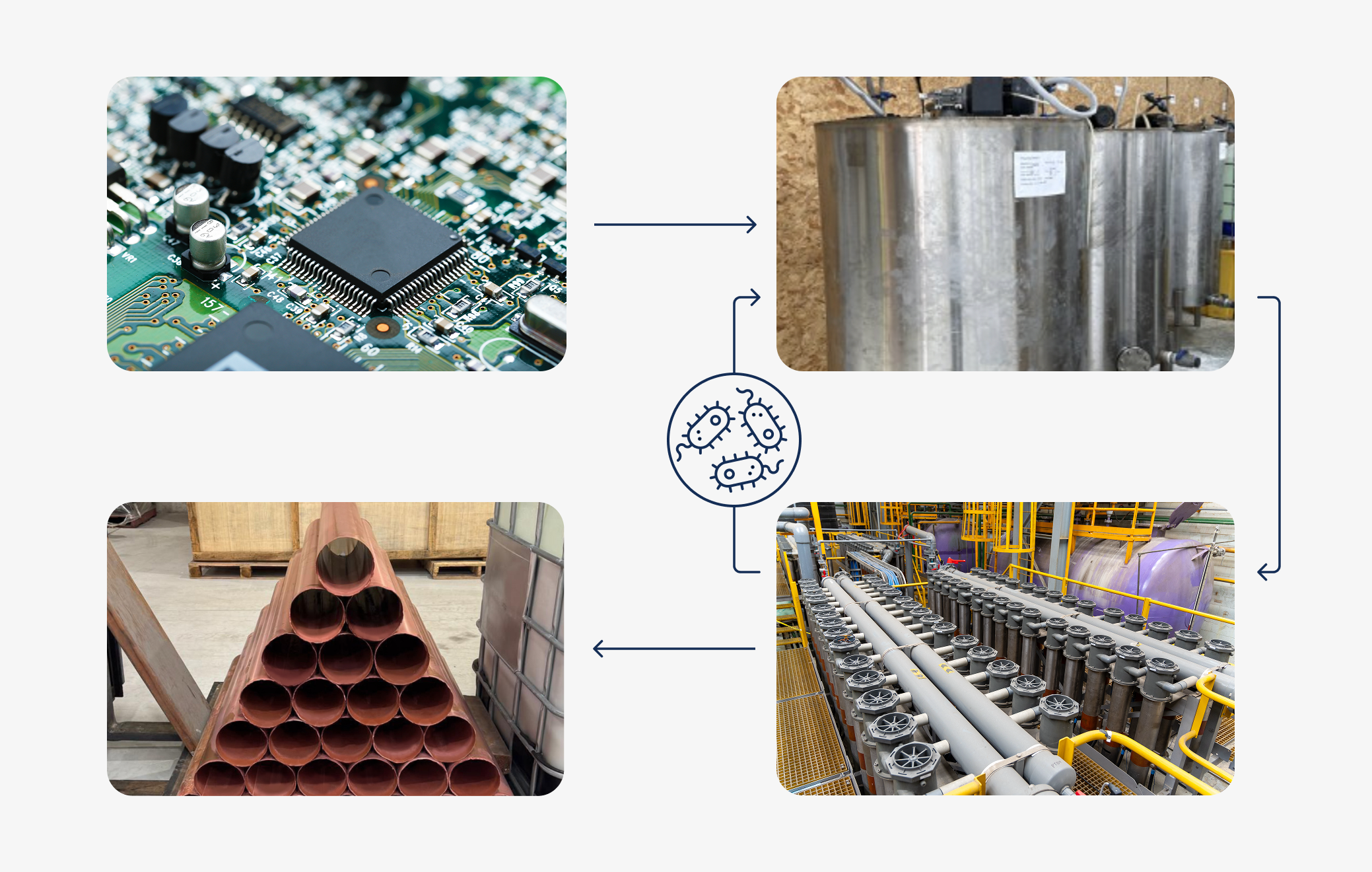Tea & Metal Recovery: An Unlikely Comparison
What do your morning cup of tea and a metal recovery plant have in common? Not a whole lot, is what you would hope! However, this is where you are mistaken. The simple act of steeping tea is, in fact, very similar to the process of leaching in metal recovery.
What is the leaching process?
Although you may be skeptical of my comparison, I assure you that I can explain what I mean. The process of leaching, by definition, is the process of extracting a substance from a solid material, after it has been in contact with a liquid. The substance being extracted from the solid does so by coming into a solution, one in which it is soluble.
This process can be equated to the dark swirls you see starting to fill your cup as you pour hot water over the tea bag. As the water pours over the tea, the colour and flavour come out of the tea leaves, and into the solution.

There are various methods for metal extraction or recovery; pyrometallurgy and hydrometallurgy are the most common. Pyrometallurgy involves smelting and refining the metal concentrate. Here at emew, we favour hydrometallurgy because we extract metals from aqueous solutions. Our technology uses an electrolytic process called electrowinning to recover various metals from solution. For us, the leaching step in the hydrometallurgical process is extremely important.
There are various leaching methods to get the target metals into solution, which can be a more environmentally friendly method of extraction, in comparison to pyrometallurgy. Depending on the desired metal, and its original matrix, different solvents can be used in the leaching process in metallurgy; these solvents are known as lixiviants. For those of you unfamiliar with the term, lixiviate means to leach, or dissolve out. The lixiviant is what leaches the metals out of the original matrix; lixiviants can be acidic, or basic. Lixiviants vary in terms of pH, redox potential, and/or chelating agents, which can help increase the rate or selectivity of dissolution of the desired metal. In an ideal world, just the metal of interest will come into solution when in contact with the lixiviant, and then can be electrowon after this step. However, this is often not the case; for example, sulfuric acid will leach most of the base metals from the solid matrix, and even some of the precious metals. Choosing a lixiviant is important in order to leach the maximum amount of the desired product, but it is also important to evaluate what other metals will end up in solution.
In the process of electrowinning, metals are plated onto a cathode based on the relative reduction potential of each metal in solution. The metal with the most positive reduction potential will plate out preferentially. Once that metal is depleted from the solution, the next most positive reduction potential will plate out. The electrochemical series dictates what metals will plate out of solution and in what order, and if pre-treatment is required after leaching in order to isolate the particular metal of interest prior to electrowinning. Current density can be adjusted within the emew cell to increase or decrease the rate of plating.

Leaching is the particular area of interest that I have been focusing on, as it is a very important step that must be completed prior to electrowinning. There are different types of leaching, and the method chosen depends on the matrix of the starting material and the desired outcome.
Vat Leaching
1) Vat Leaching: Also known as “agitated tank” leaching, the lixiviant comes into contact with the metal material in large vats or tanks, which can be stirred, enhancing the reaction kinetics. The metal-containing solid, such as concentrate, ore, residue, or slag, often undergoes size reduction via crushing and grinding prior to leaching.
One example of a leaching process that uses vat leaching is gold cyanidation, the process of extracting gold from low-grade ores. In this process, a dilute solution of sodium cyanide (NaCN) is used to leach the Au into solution. The concentration is usually 0.01-0.05 % cyanide, or 100-500ppm. It should also be noted that the alkalinity of this solution must be high enough such that hydrogen cyanide is not produced, which is a very toxic gas. This is more important when sulfide minerals are in the ore, because they will oxidize, consuming oxygen and generating acid. The pH can be kept above 10, by adding a base such as lime (CaO) to the solution, at a minimum concentration of 0.04%, when NaCN is 0.01%. Other additives include lead nitrate solution (at a ratio of 2:3 to the NaCN solution) in order to minimize cyanide consumption in the reaction. Based on different variations of gold cyanide leaching and the starting material, different concentrations and ratios of the solvents and additives are used.
Heap Leaching
2) Heap Leaching: Ore is crushed, agglomerated and charged to a heap in a container lined with an impervious layer. Lixiviant is then irrigated on top of the heap, diffused through the heap, and is eventually collected and pumped out for further processing.
Usually, this method is used on low-grade ores that cannot be economically processed via other means. Heap leaching is successfully used to extract gold, silver, copper, nickel, and uranium. The largest heap leach for gold is at the Yanacocha mine in Peru, second only to Veladero in Argentina. Heap leaching is used in tandem with electrowinning for copper extraction; approximately 16% of the world’s total copper production is extracted in this way. The Radomiro Tomic mine in Chile is a prime example of the success of copper heap leaching, followed by solvent extraction and electrowinning.
Heap leaching technology is important to the future of metal recovery, since it can be applied to extract precious and base metals sitting in abandoned tailings, and/or waste management sites. With emerging technologies and development requiring more of our natural resources, near 100% recovery becomes extremely important.

In-situ Leaching
3) In-situ Leaching: Holes are drilled into the deposit to make pathways for the solution to penetrate. The lixiviant is then pumped into the deposit, making contact with the ore, and the resulting solution is then collected and processed.
Autoclave Leaching
4) Autoclave Leaching: Higher temperature and pressure are used to enhance the rate of the reaction. This aggressive method of leaching is typically used for ores and concentrates that are not amenable to atmospheric leaching, such as sulphides.
Each variation of leaching plays an important role in mining and metal recovery, and is used in a variety of applications across the globe. Although you now see how the process of leaching is not that much different from what happens inside your tea mug, I hope that you can also see why leaching is such an important step in hydrometallurgical processing, and furthermore, what a significant part it plays in electrowinning.

References:
American Institute of Mining Engineers (1917). Transactions of the American Institute of Mining Engineers, Volume 49. Princeton University: The Institute. p. 617
Australia Government, Department of Resources, Energy and Tourism. Cyanide Management. 2008. Commonwealth of Australia
Basov, Vladimir. "Heap Leach: Mining's Breakthrough Technology | MINING.Com". MINING.Com, 2017, http://www.mining.com/heap-leach-minings-breakthrough-technology/
Eisler, R. and S.N. Wiemeyer. Cyanide Hazards to Plants and Animals from Gold Mining and Related Water Issues. Reviews of Environmental Contamination and Toxicology, 2004. 183: p. 21-54
"Lixiviant". The American Heritage Dictionary Of The English Language, 5th ed., Houghton Mifflin Harcourt Publishing Company, 2016,
Minerals Council of Australia. Fact Sheet--Cyanide and its Use by the Minerals Industry. 2005
Mular, Andrew; Halbe, Doug; Barratt, Derek, eds. (2002), Mineral Processing Plant Design, Practice, and Control Proceedings, Vancouver, Canada: Society of Mining Engineers, p. 1631, ISBN 0-87335-223-8
Muller, Mark. "Topic 3: Ore Processing And Metal Recovery". Slideshare.Net, 2009, https://www.slideshare.net/LondonMiningNetwork/ore-processing-and-metal-recovery.
Reid, Danielle. "Leaching: Definition & Process - Video & Lesson Transcript | Study.Com". Study.Com, 2017, http://study.com/academy/lesson/leaching-definition-process.html
Salter, R.S. et al. Proceedings Of The Metallurgical Society Of The Canadian Institute Of Mining And Metallurgy. Elsevier, 2013






